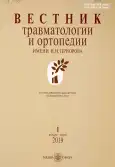Surgery tactic in humeral nonunion
- 作者: Golubev I.O.1,2, Sarukhanyan A.R.2, Merkulov M.M.1, Bushuev O.M.1, Shiryaeva G.N.1, Kutepov I.A.1, Maksimov A.A.1, Kapyrina M.V.1
-
隶属关系:
- Priorov National Medical Research Center of Traumatology and Orthopaedics
- Russian Peoples Friendship University
- 期: 卷 26, 编号 1 (2019)
- 页面: 35-41
- 栏目: Original study articles
- URL: https://bakhtiniada.ru/0869-8678/article/view/47197
- DOI: https://doi.org/10.17116/vto201901135
- ID: 47197
如何引用文章
全文:
详细
Relevance. Humerus fractures comprise 5 to 8% of all. Nonunions are uncommon, although in cases of infection, poorly vascularized beds, and open, segmental, or severely comminuted fractures, secondary bony healing may still be compromised. In cases of decreased blood supply, the choice of a vascularised bone graft seems inevitable.
Purpose of study: analysis of effectiveness and choosing indications for Vascularized bone grafts in humeral nonunion treatment.
Patients and methods. 41 humeral nonunion surgery performed from 2010 to 2017 at a single institution: Vascularized fibular grafts were done in 38 and vascularized femoral condylar grafts used in 3 cases. OR1F performed in all cases. X-ray and CT-scan used for control in all patients.
Results. After vascularized bone grafting union achieved in 36 cases (88%) in 4 to 6 month, with vascularized fibular grafts in 33 cases and with vascularized femoral condylar grafts in 3 cases.
Conclusion. Any humeral nonunion case require individual treatment tactics. Using of vascularized bone grafts can be crucial in lack of local healing process and persistent nonunions of the humerus.
作者简介
I. Golubev
Priorov National Medical Research Center of Traumatology and Orthopaedics; Russian Peoples Friendship University
编辑信件的主要联系方式.
Email: iog305@mail.ru
M.D., Ph.D.
俄罗斯联邦, Moscow; MoscowA. Sarukhanyan
Russian Peoples Friendship University
Email: annesr@mail.ru
俄罗斯联邦, Moscow
M. Merkulov
Priorov National Medical Research Center of Traumatology and Orthopaedics
Email: mer-vika@mail.ru
M.D., Ph.D.
俄罗斯联邦, MoscowO. Bushuev
Priorov National Medical Research Center of Traumatology and Orthopaedics
Email: bushuev_oleg@mail.ru
M.D., Ph.D
俄罗斯联邦, MoscowG. Shiryaeva
Priorov National Medical Research Center of Traumatology and Orthopaedics
Email: hand-clinic@mail.ru
M.D., Ph.D
俄罗斯联邦, MoscowI. Kutepov
Priorov National Medical Research Center of Traumatology and Orthopaedics
Email: kutepov_cito@mail.ru
M.D., Ph.D
俄罗斯联邦, MoscowA. Maksimov
Priorov National Medical Research Center of Traumatology and Orthopaedics
Email: aam.moscow.hand.72@gmail.com
M.D., Ph.D
俄罗斯联邦, MoscowM. Kapyrina
Priorov National Medical Research Center of Traumatology and Orthopaedics
Email: mashamv69@mail.ru
M.D., Ph.D
俄罗斯联邦, Moscow参考
- Adelaar R., Soucacos P.N., Urbaniak J. Autologous cortical bone grafts with microsurgical anastomosis of periosteal vessels. Surg Forum. 1974;25:487-9.
- Baksi D.P. Internal fixation of ununited femoral neck fractures combined with muscle-pedicle bone grafting. J Bone Joint Surg Br. 1986;68(2):239-45.
- Barrack R.L., Mulroy Jr R.D., Harris W.H. Improved cementing techniques and femoral component loosening in young patients with hip arthroplasty. A 12-year radiographic review. J Bone Joint Surg Br. 1992;74(3):385-9.
- Beris A.E., Payatakes A.J., Kostopoulos V.K., et al. Nonunion of femoral neck fractures with osteonecrosis of the femoral head: treatment with combined free vascularized fibular grafting and subtrochanteric valgus osteotomy. Clin Orthop NA. 2004;35:335-43.
- Bonfiglio M., Voke E.M. Aseptic necrosis of the femoral head and non-union of the femoral head: effect of treatment by drilling and bone-grafting (Phemister technique). J Bone Joint Surg. 1968;50A:48-66.
- Brenner P., Zwipp H., Rammelt S. Vascularized double barrel ribs combined with free serratus anterior muscle transfer for homologous restoration of the hindfoot after calcanectomy. J Trauma. 2000;49:331-5.
- Brownlow H.C., Reed A., Joyner C., et al. Anatomical effects of periosteal elevation. J Orthop Res. 2000;18:500-502.
- Buckwaiter J.A., Cruess R.L. Healing of the musculoskeletal tissues. In: Rockwood C.A., Green D.P., Bucholz R.W., ed. Fractures in adults. Philadelphia: JP Lippincott; 1991.
- Burstein F.D., Canalis R.F. Studies on the osteogenic potential of vascularized periosteum: behavior of periosteal flaps transferred onto soft tissues. Otolaryngol Head Neck Surg. 1985;93:731-5.
- Chandler H.P., Reineck F.T., Wixson R.L., McCarthy J.C. Total hip replacement in patients younger than thirty years old. A fiveyear follow-up study. J Bone Joint Surg Am. 1981;63(9):1426-34.
- Crock J.G., Morrison W.A. A vascularised periosteal flap: anatomical study. Br J Plast Surg. 1992;45:474-8.
- Daecke W., Lorenz S., Wieloch P. Lunate resection and vascularized Os pisiform transfer in Kienbock’s Disease: an average of 10 years of follow-up study after Saffar’s procedure. J Hand Surg-A. 2005;30:677-84.
- King A.R., Moran S.L., Steinmann S.P. Humeral Nonunion. Hand Clin. Nov,2007;23(4):449-56.
- Koutalos A., Varitimidis S., Dailiana Z., Bargiotas K., Koutsogiannis A., Malizos K.N. Operative management of humeral nonunions. Factors that influence the outcome. Acta Orthop Belg. 2015;81:501-10.
- Soucacos P.N., Dailiana Z., Beris A.E., Johnson E.O. Vascularised bone grafts for the management of non-union. Int J Care Injured. 2006;37:41-50.
- Zafra M., Uceda P., Carpintero R. Recon-struction of massive bone loss in the elbow using vascularized fibular transfer: a case report. J Shoulder Elbow Surg. 2015;24:el44-e7.
- Zhi-Kui Z., Yuan L.M., Jiang P.P., Huang F. Case Report. Treatment of 10 year humeral shaft nonunion with segment bony defect: a case report. Int J Clin Exp Med. 2016;9(10):20242-6.
补充文件




















